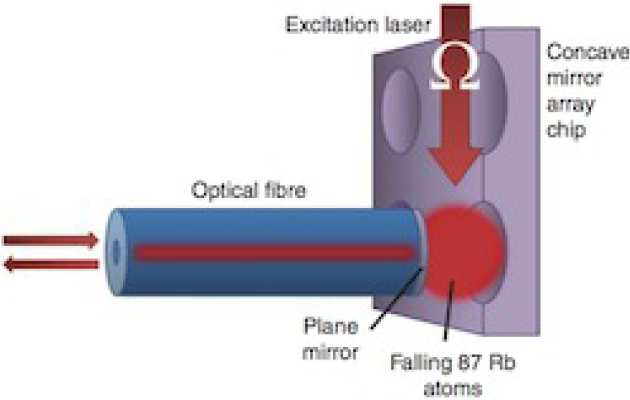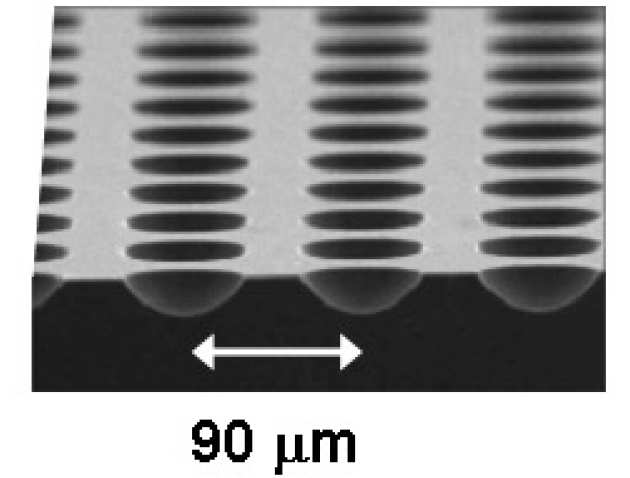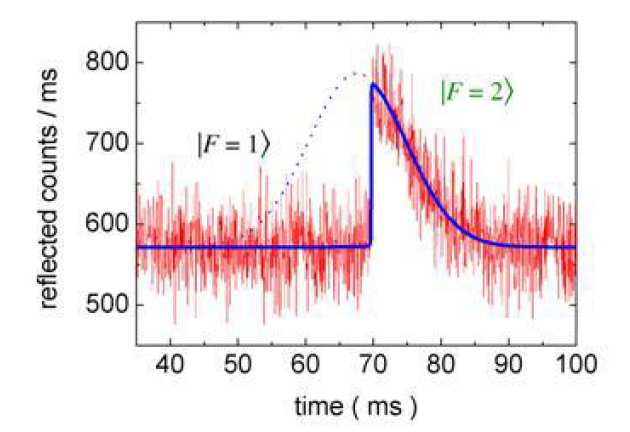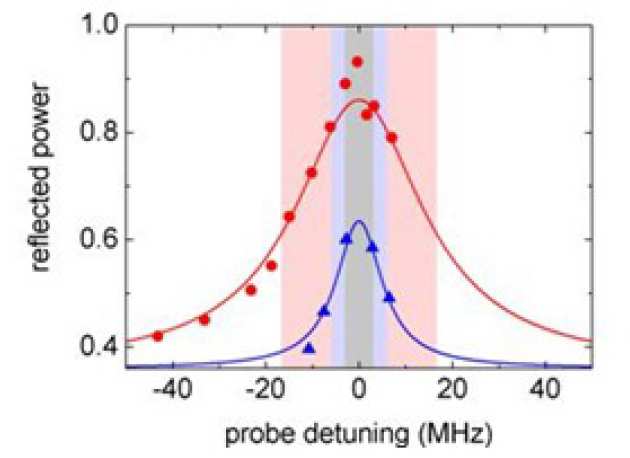Cavity QED with Arrays of Micro-fabricated Cavities
The field of quantum information processing (QIP) aims to harness unusual properties of quantum mechanics, such as entanglement and superposition, to achieve an exponential speed-up in certain types of computing tasks. For efficient scalable QIP networks, we require suitable qubits both for long-lived storage, and for point-to-point communications. Atomic systems offer extremely long coherence times (on the order of 1 second), but are not easily transported over long distances; photons are ideal for long-distance communication, but are not easily stored. Fortunately the essential gate operations have been performed with some success on both atomic and photonic systems. The outstanding challenge therefore is to develop robust and efficient means for transferring quantum information between light and matter.
Cavity QED with Arrays of Micro-fabricated Cavities
Coupling Atoms and Photons
 Roughly speaking, efficient interaction between single photons and atoms relies on focusing a beam of light to an area similar to the photon absorption cross-section of the atom. But this means having a beam size on the order of the square of the wavelength, which is technically challenging to achieve. At the Centre for Cold Matter at Imperial College we are developing a suite of new optical technologies for integration into atom chips - specially designed microfabricated structures - which can be used to cool, trap, and manipulate atoms at temperatures below a millionth of a degree above absolute zero. By working with atoms in the vicinity of microfabricated optics and structures, we can observe significant interactions at the single-atom/single-photon level. Furthermore, the intrinsic scalability of these components renders them useful for applications in distributed QIP networking.
Roughly speaking, efficient interaction between single photons and atoms relies on focusing a beam of light to an area similar to the photon absorption cross-section of the atom. But this means having a beam size on the order of the square of the wavelength, which is technically challenging to achieve. At the Centre for Cold Matter at Imperial College we are developing a suite of new optical technologies for integration into atom chips - specially designed microfabricated structures - which can be used to cool, trap, and manipulate atoms at temperatures below a millionth of a degree above absolute zero. By working with atoms in the vicinity of microfabricated optics and structures, we can observe significant interactions at the single-atom/single-photon level. Furthermore, the intrinsic scalability of these components renders them useful for applications in distributed QIP networking.
Optical Microcavities
 Arguably the most successful method for increasing the interactions between single atoms and photons is to confine them within high-finesse optical microcavities. Here very small mode volumes can be achieved, leading to large single-photon Rabi frequencies, and with relatively long interaction times. At Imperial our resonator design includes a microfabricated spherical mirror, whose small radius of curvature leads to a coherent evolution rate which is ~60 times faster than the spontaneous decay rate of an excited atom in free space, giving rise to a large effective optical depth for even a single atom. Additionally, one mirror of the Fabry-Perot resonator comprises the tip of a single-mode optical waveguide, potentially allowing mode-matched input/output coupling across whole arrays of cavities. By combining our small mode volume with a fast output coupler mirror, we efficiently convert atomic excitations into waveguide-coupled photons without suffering re-absorption.
Arguably the most successful method for increasing the interactions between single atoms and photons is to confine them within high-finesse optical microcavities. Here very small mode volumes can be achieved, leading to large single-photon Rabi frequencies, and with relatively long interaction times. At Imperial our resonator design includes a microfabricated spherical mirror, whose small radius of curvature leads to a coherent evolution rate which is ~60 times faster than the spontaneous decay rate of an excited atom in free space, giving rise to a large effective optical depth for even a single atom. Additionally, one mirror of the Fabry-Perot resonator comprises the tip of a single-mode optical waveguide, potentially allowing mode-matched input/output coupling across whole arrays of cavities. By combining our small mode volume with a fast output coupler mirror, we efficiently convert atomic excitations into waveguide-coupled photons without suffering re-absorption.
Seeing single atoms
We have used these resonators to demonstrate chip-based cavity-enhanced spectroscopy with better than single-atom sensitivity. By reflecting a weak (~1 pW) probe beam from the cavity onto a single photon counter, we detect changes of the light level as small clouds of cold atoms traverse the cavity mode. Because the light-matter interactions are dependent on the internal (spin) state of the atoms, they can additionally be turned on and off during the experiment, effectively "shelving" the atoms in a dark state, in analogy with previous work with trapped ions, as shown in Figure 1. By varying the probe laser detuning we observe the effects of the atoms on the spectral properties of the cavity, including the cooperative behaviour of otherwise non-interacting atoms, mediated by their common interaction with a single mode of the cavity field, as first described theoretically by Dicke in the 1950's. This cooperative enhancement results in a spectral feature whose linewidth is proportional to the number of atoms, demonstrating directly the collective nature of the photon emission process. An example is shown in Figure 2.
|
Figure 1: Dark state "shelving" of atoms passing through the cavity. A cloud of 87Rb atoms initially in the F=1 ground state is optically pumped into the F=2 state around 70 ms, leading to a turn-on of the atom-cavity interactions, as evidenced by the change in reflected light level. |
|
Figure 2: Cooperative effects on the atom-cavity spectral lineshape. The Purcell effect broadens the atomic feature from the natural linewidth (grey band, FWHM) as shown in blue. Increasing the number of atoms in the cavity further broadens the lineshape (red). |
Qubits on demand
In the context of QIP networking, we have been studying how photons can efficiently be created in the cavity mode, and carried out via the waveguide. Due to the Purcell effect, even spontaneous emission becomes directional, preferentially populating the single mode of the cavity field. With our fast output mirrors, and direct single-mode waveguide coupling, we efficiently produce and detect photons in this way. As an example, we can detect the equivalent of a single atom's resonance fluorescence with greater than 90% efficiency in only 10 microseconds. By controlling the polarisation of the pump light, we can tune the fluorescence rate into the cavity by effectively redistributing the atomic populations among the various Zeeman magnetic sublevels.

Figure 3: Polarisation control of resonance fluorescence. Left: effect of pump polarisation on photon production in the cavity mode. Right: theoretical model with optical pumping into large-|m| Zeeman states resulting in better coupling to the sigma +/- cavity modes
Contacts
For more details contact Dr. Yu-Hung Lien (yu-hung.lien [at] imperial [dot] ac.uk).
Some Relevant Publications
ICP polishing of silicon for high-quality optical resnaotors on a chip
A. Laliotis, M. Trupke, J. P. Cotter, G. Lewis, M. Kraft, E. A. Hinds
Journal of Micromechanics and Microengineering 22, 125011 (2012)
Fast cavity-enhanced atom detection with low noise and high fidelity
J. Goldwin, M. Trupke, J. Kenner, A. Ratnapala, E. A. Hinds
Nature Communications 2, 418 (2011)




